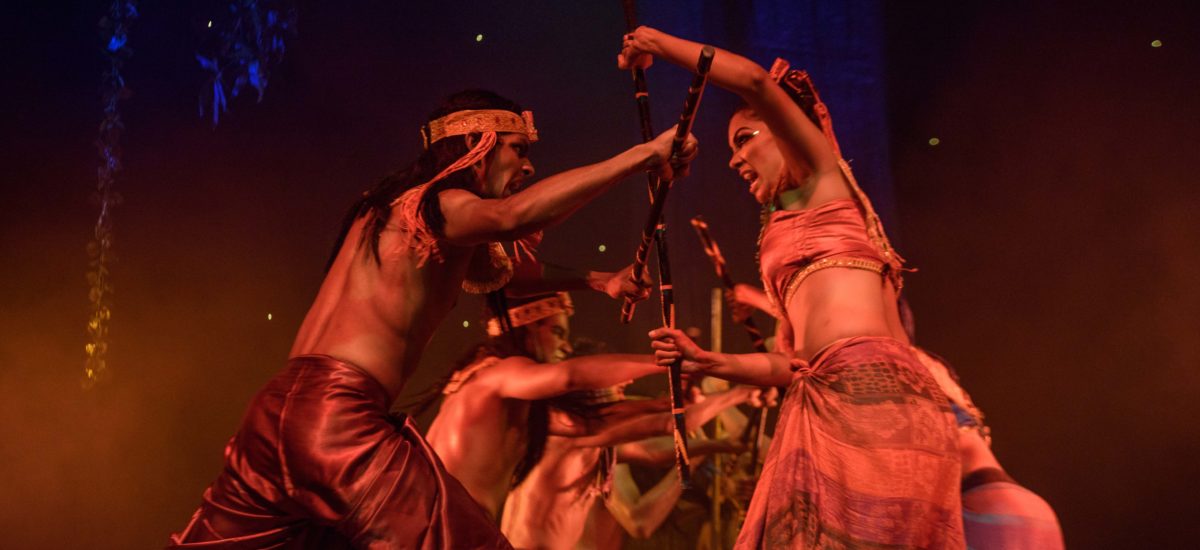‘Enchantment galore’ upon the senses of theatregoers seemed the motive and motif for the twelfth year anniversary show of ‘Pyramus and Thisby’ written and directed by seasoned theatre practitioner Jehan Aloysius, which unfolded on the boards of the Wendt on the 7thof July. From the very outset it was clear that this was a labour of great passion displaying skill and planning on the part of the theatre company Centre Stage Productions headed by Aloysius. Yours truly bore witness to every second of the ‘performance’ of this celebration of the magic of theatre that started, strictly speaking, not on the boards of the auditorium but the space of frontal pavement of the Lionel Wendt Arts Centre where a torch lit skit of ritual like revelry was performed to set the mood as to what kind of rambunctious comedy was to erupt indoors once the bell rang to start the show. This palette whetting preshow skit was a theatricalised announcement and introduction of sorts done in olden Sinhala folk drama style as to ‘who would be what’ in the stage play called ‘Pyramus and Thisby’. It was a precursor that revealed how a theatre troupe led by its director Peter Quince, was plotting course to stage a play. The troupe of thespians found in Shakespeare’s ‘A Midsummer Night’s Dream’ thus announced their birth as bilingual Sri Lankans to set the pace for what is an innovation ‘inspired’ by Shakespeare’s celebrated comedy, though perhaps not a fully fledged adaptation.
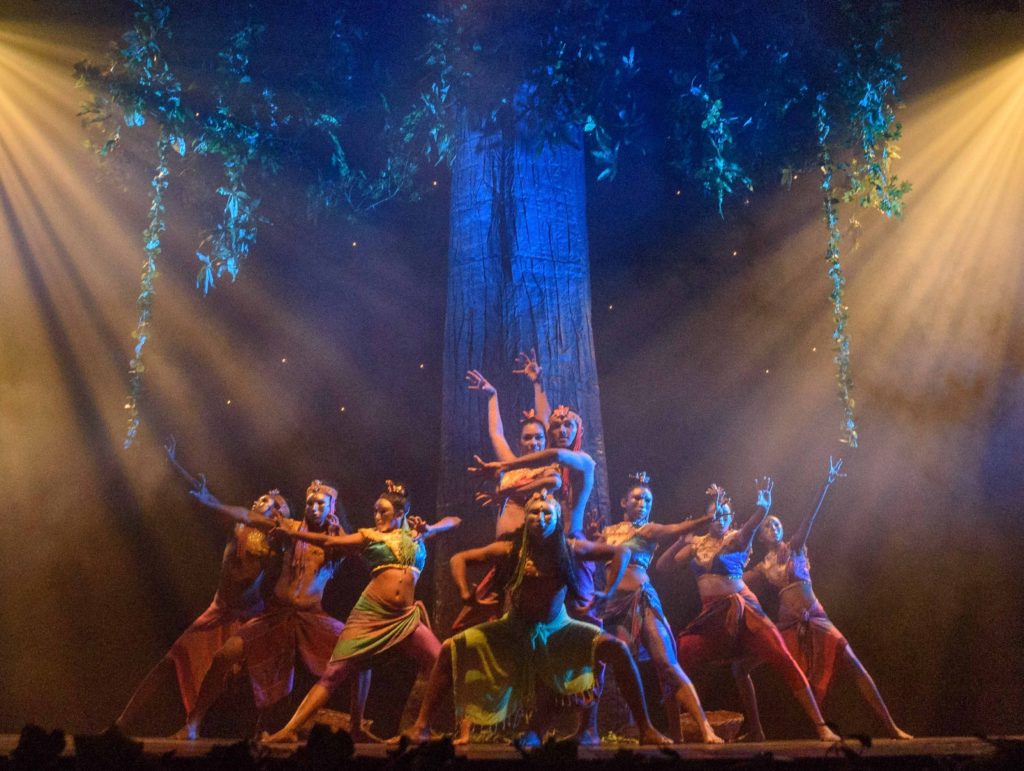
The production’s motif was consistent in carrying forth the theme and idea of enchantment through music, choreography, costumes, and lighting which had the motive of mesmerising the audience. The wondrous dance scenes of the fairy folk were dazzling displays giving motion to form and colour with rhythm. The impressive choreography included agile and dextrous acrobatic moves evincing much planning and rehearsal being committed to realise the vision of this production. Garbed in stunning costumes of eastern designs, Roshni Gunaratne as Titania, the queen of the fairies, and Kavishka Perera as king of the fairies Oberon, proved a spectacular couple as fairy folk royalty gracing the stage with notable artistry of dance together with their respective entourages of fairy folk. The dance sequences showed clarity of character moods through motion. Dance in this stage play was not mere ornamentation. It was part of the nonverbal communication, adding to the fabric of performance as part of the ‘nonverbal text’ of Aloysius’s work. Dance showed amity and amorousness between the king and queen of fairies were visible as much as their animosities when the scenario occasioned it. Dance was thus an aspect of ‘wordless narrative’.
With regard to music and choreography applause are due to Jehan Aloysius and Avanti Perera who jointly bear credit for this aspect of the production. Applause is also due to Aloysius for his design of costumes which had an entirely eastern base, and commendation must also be made of Hilma Salahudeen who is credited for stitching the costumes of this production. Operating of lights by Thushan Dias, and sound by Stephan Wijesinghe, must be noted as jobs well done.
Oberon and Titania displayed elegance of rhythmic motion and spoke dialogue that was stylised and sounded ‘ornate’ and rehearsed. The strengths of Gunaratne and Perera as artistes in this performance I believe came out mostly through the element of dance. However one may view this stylised dialogue (by which I do not mean the diction, which was Shakespearean, but the manner of enunciation and delivery) as a possible rendition of the surreal nature of the fairy folk as opposed to the ‘humanly real’ characters in the drama troupe of Peter Quince. Thereby one may say Aloysius designed schemes for dialogue style to differentiate the nature of character categories. If that was the case, then yes, it was successful.
The character of Puck aka Robin Goodfellow, played commendably by Dion Nanayakkara, was in my opinion a dialogically underdeveloped and underutilised role. He was very much the mischief maker and lived up to his purpose with action and agility, but more verbal contribution to the text from this colourful character would have been welcome.
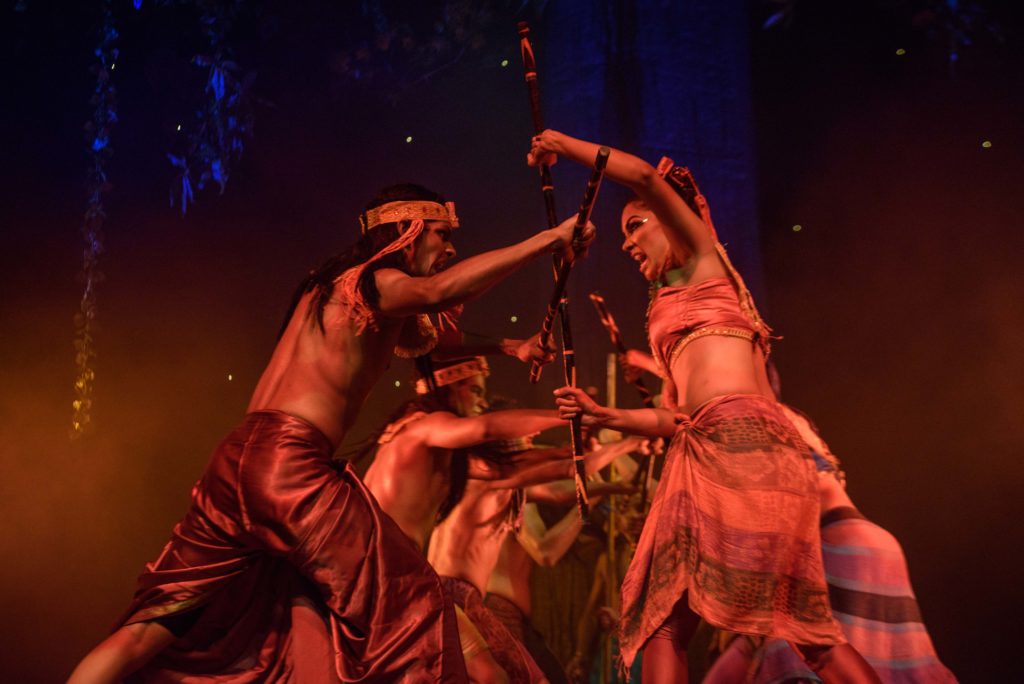
The nonverbal narrative aspect of the play included an authentic traditional olden Sinhala folk cultural element in the form of a Naaga Raaksha dance (devil dance) complete with a traditional drummer. This element takes place before Titania awakes from her sleep and sees Bottom with whom she falls in love as a result of the juice of the flower called Love in Idleness having been secretly administered on her as per Oberon’s scheme to win her over. It was perhaps meant to serve as an element of a dream unfolding in slumbering Titania. However I cannot help but feel it appeared superimposed upon the story narrative as an ‘exotic element’ for the sake of showcasing Sri Lankan ritualism. That item could have been shortened, as it served to lengthen the performance without apparent structural function. It was more ornamentation than narrative.
The nature of Pyramus and Thisby had a clear meta-theatre facet to it, breaking the fourth wall the play included elements in dialogue that admitted the characters in Quince’s troupe were self aware of performing to a live audience.
Pyramus and Thisby cannot be called an English Sri Lankan play. It is patently a Sinhala – English bilingual play. A genre that is reflective of contemporary Sri Lanka, and more so our flourishing urban culture. Works of Sinhala–English bilingual theatre require an audience to be competent in both Sinhala and English as mediums of verbal communication, and thereby specifically addresses Sri Lanka’s ‘urbane urbanism’. This is a play with a spectrum of language variance where the text has Shakespearean diction (of ‘thou art’ form) juxtaposed with rustic bawdy colloquial Sinhala! The text showed layers of language that is creditable of Aloysius as a playwright.
Shakespearean diction was principally the preserve of Oberon and Titania and contemporary English parlance and substandard Sri Lankan English which included erroneous enunciation and mispronunciation of words like Pyramus as ‘Fyramus’ by Bottom, was designated to Peter Quince’s troupe. It is a comedy of side splitting laughter that won over its audience hands down. Aloysious showed through his script, his brilliance in writing comedy that captures the pulse of a Sri Lankan audience.
The comedy generated by this play worked at many levels. There were scripted mishaps (that are characteristic of meta-theatre), slapsticks, witticism and tomfoolery, as well as bawdy language and gestures that were sexually nuanced. How much of that was vulgarity and how much of it was riotous comedy I will not judge. On that matter I feel each should decide on their own how qualified the performance was to be a show for the whole family. Another aspect to note is that there was a pervasive homoerotic vein woven into the demeanours of Peter Quince and his minions. Quince, played by seasoned actor of the English stage Anuk de Silva, was no doubt entertaining, but was at times a tad overdone in ‘playing the pansy’; thus losing the spark of the ‘drama queen’ with too many over the top theatricalised projections of the character’s ‘orientation’. The finesse of subtly was not a virtue visible in giving shape to Quince’s humour through homoeroticism.
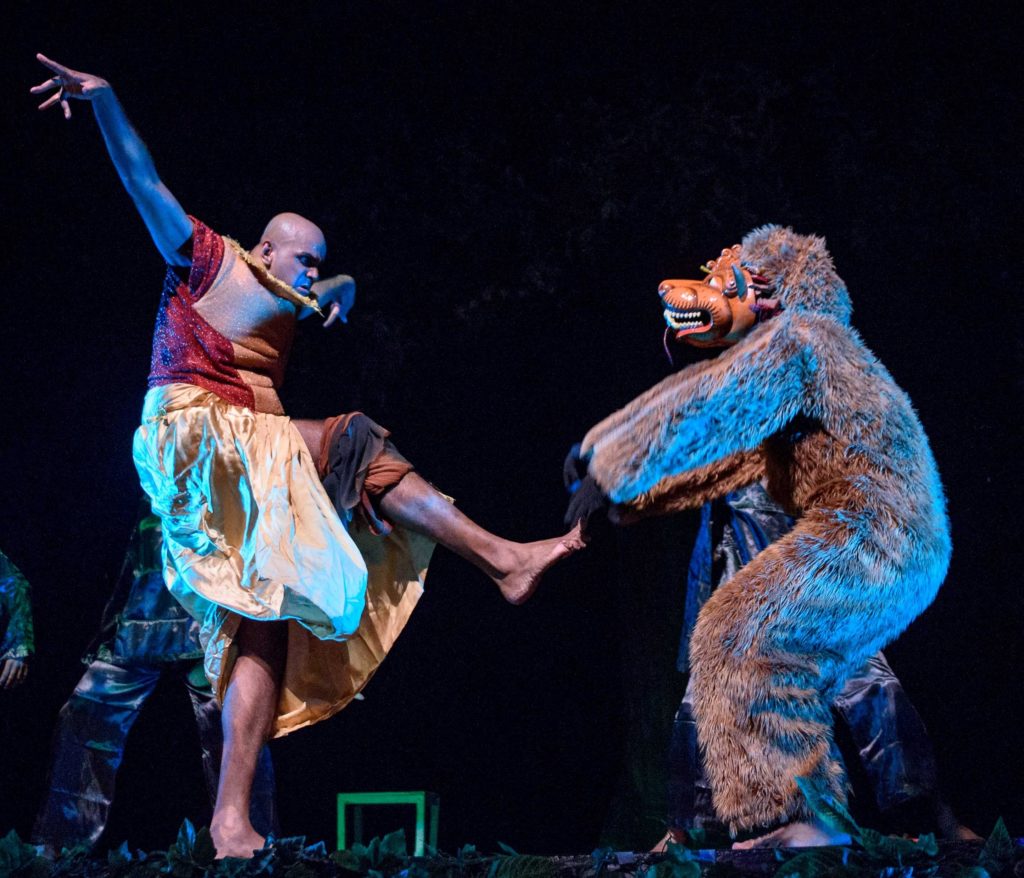
Bottom, who was the principal life of the party, was played with exponential skill by Jehan Aloysius. He had his audience in raptures. Here is an actor who knows how to commandeer every second of his presence on stage to make it perceived and purposeful. Aloysius’s (very) being as an actor shone that evening as though every atom in his body was designed to give life to his character. I would say in general the players on stage all did a decent job and showed no detectable signs of stage fright or visibly poor acting.
The part where Titania sees Bottom as an ass after waking from her sleep and is love struck due to the love potion administered on her, and she begins spinning her allure to seduce Bottom, gave way to what I believe to be a notable facet of masculine politics. Bottom’s behaviour showed a form of postcolonial rustic masculine confidence. Titania was speaking in Shakespearean English and Bottom was being a typical lovably rustic macho man who wasn’t overawed by the sophistication of the enchanting female. Bottom saw Titania’s behaviour as ludicrous and said in Sinhala “Me genita pissu!” which would translate to English as ‘This woman is mad’. Bottom was at that moment the rustic who is confident and comfortable in his being and not unsettled by the sophistication displayed before him. As I see it, that part was a symbolic nuance of the strength of the primordial man. This vein of masculinity is further compounded in the manner he responds to the females he’s offered as concubines by Titania in her efforts to entice him to remain with her. Bottom’s responses were racy and uncouth, and he won the audience over with natural ease.
What were the ‘politics’ of this play? Many are focused on dissecting the ideological underpinnings of a work of art presuming that every work of art ‘must have’ socio-political ‘messages’ embedded in it. Based on my observations this appeared more a work of aestheticism than didacticism. Art for the sake of art; beauty being the primary objective, and not messages about morals or socio-political views.
Stagecraft was designed to show one principal setting –the forest, characterised by an impressive centrepiece, a tree, around which unfolded, in minimalist design, settings with props such as Titania’s royal bed, to suit different moments in the narrative. Stagecraft was thus basically designed to show an arboreal environment of the fairy folk into which Quince and his troupe immerse to experience the unfolding enchantment. It was a very technically sound approach that utilised space and light to maximum advantage to project mesmerising scenes.
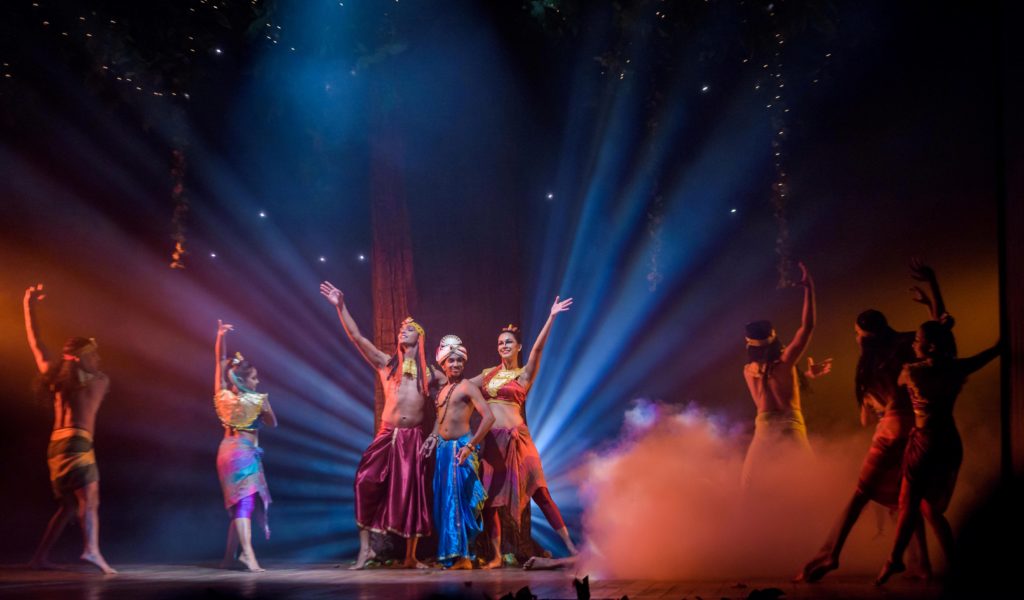
I shall now move on to comment on an aspect of this production which I believe warrants censure, being a stunt that went too far, done as a measure to devise an ‘audience participated scene’. At a certain point in the play, Peter Quince declares the need to hold an audition to fill the shoes of Bottom whom he fears has walked out of the production. What ensued seemed at first an innocuous ‘search’ for volunteers from the audience with Quince and his men looking for suitable candidates calling out to ‘sudu kollo’ (fair complexioned boys) who would like to get on stage and try out for Bottom’s part as Pyramus in the drama they planned to perform in the enchanted forest. But as there did not appear to be any viewers wholeheartedly volunteering with spontaneity, the thespians roaming the aisles proceeded to coerce viewers to become participants in their scheme of ‘performance’. Well known broadcaster and corporate etiquette trainer Mr. Kumar de Silva who was seated one row ahead of mine and by the aisle was literally dragged out of his seat and taken on stage. Two other gentlemen from the audience were also brought up on stage by the actors playing Quince’s henchmen. The character of Quince then proceeded to try out each of the three ‘participants’ by subjecting each of them to a test to see how well they would deliver a performance. From the looks on the faces of the three gentlemen who were taken up to the stage it was evident that they were considerably uncomfortable with the onstage situation they were trapped in. It was clear that they were practically held prisoner on stage as the last in the row of threw was even gripped by his wrist at one point by one of the actors preventing him from walking off the stage!
In pervading the quality of homoeroticism as part of Quince’s nature, the gentleman who was third in the line was touched in a manner on his upper torso area which he found objectionable and expressed displeasure by pushing away the hands that sought to grope him. The first person in this line of victims was a young man who appeared of late teenage vintage. This young man was told to run up to the player designated to play Thisby and plant a kiss on his cheek. This young viewer clearly expressed his objection to what he was being coerced to do and simply shook his head as his face evinced anxiety that soon tensed into anguish as the character of Quince persisted that ‘it was ok’ and that he should simply give the male player a peck on the cheek. Twice told, yet the involuntary ‘participant’ did not comply and stood his ground, but Quince didn’t seem to respect the wishes of the non-thespian who was cornered in a situation he didn’t know how to handle before an audience which was much to my disgust laughing at the predicament of that young man haplessly captive on stage.
I couldn’t believe how Anuk de Silva playing Quince could be so insensitive to persist with his demand not seeing how much discomfort and torment was visible on that young man’s face. He was finally ‘released’ as he didn’t comply with the dictates of the director Quince, and was jeered by Quince and his accomplices for being a spoilsport, as he walked back to his seat.
What must be pointed out as pertinent in this fiasco is how the artistes of Centre Stage Productions in planning this disastrous coup to build a scene with audience participation didn’t seem to grasp how the thespian mindset differs from the layman’s. Artistes who perform before a live audience are trained, and possess a psychological mettle that is ready for the task of doing what they have agreed to do before a live audience. A haphazardly picked out candidate from a seat in the auditorium does not possess that same ability to handle himself on stage. It is their dignity that is at stake when they are made to feel that they must prove themselves capable of handling themselves on stage or be seen as ‘scared’ or ‘backward’. In such a situation the truth of it is that the audience member’s ‘dignity’ is held hostage.
What transpired on stage through this nonsensical stunt was a crass disregard for the dignity of audience members. Centre Stage Productions should have had better sense to realise they must not resort to these types of stunts that blatantly violate the right of audience members to be treated with respect. Thespians must realise that in their zeal to break the fourth wall and experiment with audience participatory measures they cannot turn their viewers into playthings to be dragged on stage, kept prisoner and perform to their dictates.
I was appalled by the insensitivity of a number of fellow audience members who thought it funny when the young man was being coerced to plant a kiss on the cheek of a man. Looking at the nature of the scenario it was quite evident that young man and the two other gentlemen were objectified to be laughed at by audience members. For the record dear reader I did not find any part of this stunt a laughing matter and was shocked in silence at how three audience members who were clearly not thespians were being coerced to ‘perform’ in full view of an audience. If you are a parent just think for a moment if you would appreciate a situation where your child is being coerced to ‘perform’ various acts in full view of an audience?
Members of the audience have a right to watch the show without being physically dragged out of their seats and subjected to the dictates of trained artistes. This incident was a clear case of the will of the artistes being thoughtlessly imposed upon laymen in the confines of a ‘performing space’ where the ‘artiste is king’. And this is all very intriguing being in a show by Centre Stage Productions which gave theatregoers ‘Rag, The Musical’ (which I reviewed in the 26/11/2017 issue of Sunday Observer) which carries a strong statement against ragging.
There may be different views on this matter depending on points of observation. I do believe from a point of concern for perspective on the experience the best persons to comment would be the three audience members who were subjected to the injurious antics of the artistes. As I can only identify Mr. Kumar de Silva from the three persons I would request interested persons to seek Mr. de Silva’s point of view on this matter through social media or other channels, whether it seemed purely harmless or far more insalubrious than what the artistes may have thought it to be. I know Mr. de Silva is a man of integrity who can speak out without fear or favour and offer his genuine thoughts on this matter. And I further hope serious discussion can take place between theatre practitioners in Sri Lanka on adopting standards to be adhered for ethical treatment towards audience members.
For the record I wish to state that I was in fact invited to this show by Centre Stage Productions who very thoughtfully offered me seat E 12. I do indeed appreciate the gesture. When reviewing a production I do not judge it based on one single aspect, therefore while applauding what is praiseworthy in ‘Pyramus and Thisby’ I will not hesitate to call a spade a spade regardless of whether I was an invitee or a viewer who purchased a ticket. As a reviewer my duty is firstly to my readers. This was a shameful stunt by Centre Stage Productions that crossed a line when it comes to breaking the fourth wall. I condemn this particular part of the show unreservedly.
Looking at the overall picture (discounting the aforementioned stunt of course), taking the ‘performance as a text’ made up of dialogue, music, lighting, dance, together with the whole visual component projected from the stage, what was ‘Sri Lankan’ about ‘Pyramus and Thisby’? In terms of dialogue, Sinhala diction was not merely peppering for spiciness of the script but integral to the scenario. There was Sinhala and English ‘code-mixing’ as well as ‘code-switching’ done with accurate grammatical structural integrity characteristic of natural bilinguals. Costumes, styles of dance and music were of an eastern form. It is a production with overtones of eastern aesthetics, built on a story idea extracted in part from Shakespeare’s ‘A Mid Summer Night’s Dream’, fusing different layers of language from two cultures to create a work that was innovatively urban Sri Lankan. This was innovation that showed originality. Original theatre in Sri Lanka must be supported and applauded. Through ‘Pyramus and Thisby’ Aloysius and his team present a work that is a credit to Sri Lankan theatre. And for the record this production elicited at end of the curtain call a standing ovation from the (re)viewer who occupied seat E 12 that night at the Wendt.
An edited version of this review was published in the Sunday Observer on 15 July 2018. All photos provided by author.

